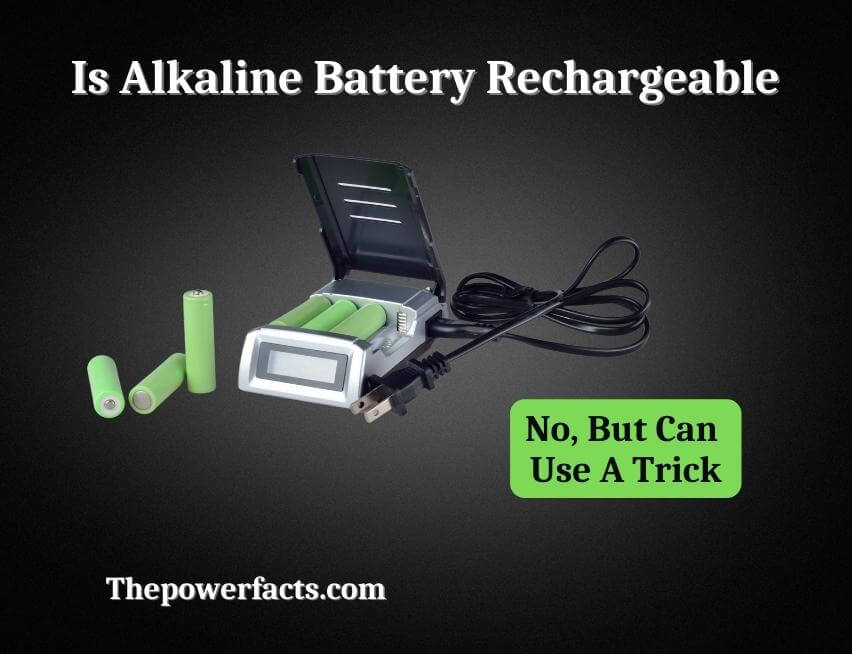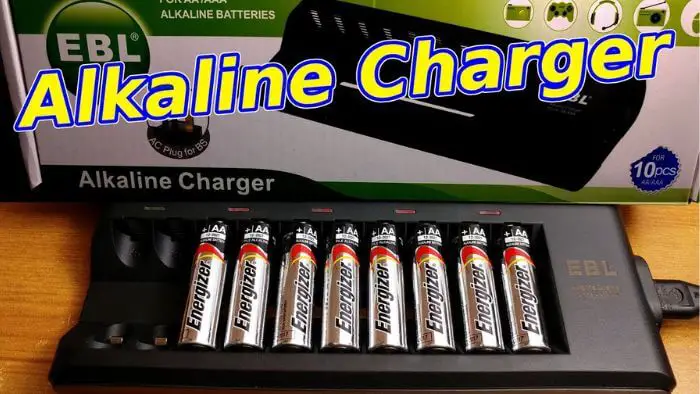As we all know, battery technology has come a long way in recent years. We now have lithium-ion batteries that can power our electronic devices for hours on end. But what about alkaline batteries?
Are they rechargeable? The answer is yes and no. You see, alkaline batteries are not technically rechargeable.

However, there are ways to “trick” them into accepting a charge. This process is known as “rejuvenation” and it can extend the life of your batteries significantly.
Alkaline batteries are made with a zinc anode and a manganese dioxide cathode. The electrolyte used in these batteries is potassium hydroxide.
When the battery is in use, the zinc anode reacts with the electrolyte to produce zinc oxide while the manganese dioxide cathode reacts with water to produce manganese oxide.
- The main advantage of alkaline batteries over other types of primary batteries is that they have a much higher energy density. This means that they can store more energy per unit weight or volume than other types of primary batteries.
- They also have a longer shelf life than other types of primary batteries, making them ideal for use in devices that are not used often or for emergency backup power supplies.
- Although alkaline batteries cannot be recharged, they can be recycled. Recycling helps to conserve resources and prevent pollution. There are many companies that will recycle your old alkaline batteries for you. Battery acid may burn through metal when it goes old.
Are All Alkaline Batteries Rechargeable?
No, not all alkaline batteries are rechargeable. In fact, most alkaline batteries cannot be recharged. Only a few types of alkaline batteries can be recharged, and even then, they can only be recharged a limited number of times.
The reason that most alkaline batteries cannot be recharged is because they are not designed to be recharged. The chemicals inside an alkaline battery are not meant to be used over and over again. When you try to recharge an alkaline battery, the chemicals inside break down and the battery will no longer work properly.
There are a few types of alkaline batteries that can be rechargeable, but they can only be charged a limited number of times before they need to be replaced. These types of batteries are called “rechargeable alkalines.” They are more expensive than regular alkaline batteries, but they will last longer if you use them correctly.
If you have any questions about whether or not your types of batteries is rechargeable, it is best to consult the manufacturer’s instructions or contact customer service for more information.
How Do I Know If a Battery is Rechargeable?
There are a few ways to tell if a battery is rechargeable.
| One way is to look at the chemical composition of the battery | Most disposable batteries are made with alkaline or carbon-zinc chemistry, while most rechargeable batteries are made with nickel-cadmium, nickel-metal-hydride, or lithium-ion chemistries. |
| Another way to tell if a battery is rechargeable is by its voltage | Disposable batteries typically have 1.5 volts, while most rechargeables have between 3 and 4 volts. |
| Finally, you can usually tell if a battery is rechargeable by its size and shape | Rechargeables are often larger and heavier than disposables, and they may have different connector types (e.g., cylindrical versus flat). |
Are Duracell Alkaline Batteries Rechargeable?
No, Duracell alkaline batteries are not rechargeable. Duracell is a brand of battery owned by Gillette. It produces several types of batteries, including lithium-ion, nickel-metal hydride, and alkaline batteries.
Alkaline batteries are the most common type of battery in use today. They are used in many household items such as flashlights, remote controls, and toys. Alkaline batteries get their name from the fact that they use an alkaline solution to create electricity.
This solution is made up of potassium hydroxide and sodium hydroxide. The chemical reaction between these two substances creates electrons, which flow through the wire to create an electric current. When the battery is depleted, the electrolyte solution becomes exhausted and needs to be replaced.
Why Aren’t Alkaline Batteries Rechargeable?
Alkaline batteries are not rechargeable because they don’t contain the necessary materials. Rechargeable batteries contain metals like cobalt, nickel, and manganese which can be returned to their original state through an electrolytic process. Alkaline batteries only contain zinc and manganese, so they cannot be recharged.
Is Duracell Alkaline Battery Rechargeable?
No, Duracell alkaline batteries are not rechargeable. Alkaline batteries cannot be recharged because the chemical reaction that occurs during discharge cannot be reversed. Once an alkaline battery is discharged, the chemicals inside the battery can no longer produce the electrical current needed to power a device.

Rechargeable Alkaline Battery AA
A rechargeable alkaline battery is a battery that can be reused many times before it needs to be replaced. These batteries are made with a special type of alkaline material that allows them to hold a charge for much longer than traditional alkaline batteries. Rechargeable alkaline batteries are available in many different sizes, but the most common size is AA.
These batteries can be used in a variety of devices, including digital cameras, remote control toys, and portable electronic devices. There are several benefits to using rechargeable alkaline batteries. Firstly, they are much more environmentally friendly than disposable batteries because they can be reused over and over again.
Secondly, they save you money in the long run because you don’t have to keep buying new batteries all the time. And finally, they provide a longer-lasting power source for your devices so you don’t have to worry about them running out of juice in the middle of use.
How to Recharge Alkaline Batteries Without Charger?
If your alkaline batteries are dead, you can’t just plug them into the charger and expect them to work again. Here’s how to recharge them without a charger:
1. Remove the battery from the device it powers.
2. Place the battery on a flat surface with the positive (+) side up.
3. Using a small screwdriver or another sharp object, carefully pierce the top of the battery to create a hole. Be careful not to damage the battery cells inside.
4. Insert one end of a jumper wire or alligator clip into the hole you created in step 3. Make sure that this connection is secure and does not touch any other part of the battery.
5. Connect the other end of the jumper wire or alligator clip to an exposed metal surface on your car chassis (such as a bolt). This will serve as your “ground” connection.
If you don’t have access to a car, you can use any metal object that is electrically conductive (such as a copper pipe). Avoid using anything made of aluminum, as this will not work as well.
6.” Touching” both ends of the jumper wire or alligator clip with your fingers is an alternative way to establish electrical contact if Step 5 above is not possible or practical.
7.”Be very careful when doing this so that you do not accidentally electrocute yourself!”
Alkaline Battery Charger
An alkaline battery charger is a device that charges alkaline batteries. There are two main types of alkaline battery chargers: linear and switch-mode. Linear chargers use a constant current to charge the batteries, while switch-mode chargers use a pulsed current.
Switch-mode chargers are more efficient than linear chargers and can charge the batteries in a shorter time.
Alkaline batteries have a higher voltage than other types of batteries, such as lead-acid batteries. This means that they can provide more power for a given weight and size.
However, alkaline batteries also have some disadvantages. They have a shorter life than other types of batteries and they self-discharge more quickly when not in use.
To prolong the life of your alkaline batteries, it is important to store them properly when they are not in use.
Always store the batteries in a cool, dry place out of direct sunlight. If you will be storing the batteries for an extended period of time, consider charging them once every six months to keep them fresh.
Rechargeable Battery
A battery is a device that stores energy and converts it into electrical current. A rechargeable battery is a type of battery that can be used multiple times by being recharged with an electrical current. There are many different types of rechargeable batteries, each with its own advantages and disadvantages.
Lead-acid Battery
The most common type of rechargeable battery is the lead-acid battery. Lead-acid batteries are typically used in cars and other vehicles. They are very durable and have a long life span, but they are also very heavy and can release harmful chemicals if not properly disposed of.
Nickel-cadmium (NiCd) Battery
Another common type of rechargeable battery is the nickel-cadmium (NiCd) battery. NiCd batteries are lighter than lead-acid batteries and do not release harmful chemicals, but they have a shorter life span and can be more expensive.
Lithium-ion (Li-ion) Battery
Lithium-ion (Li-ion) batteries are the newest type of rechargeable battery on the market. Li-ion batteries are lightweight, have a long life span, and do not release harmful chemicals, but they can be more expensive than other types of batteries.
Are Alkaline Batteries Recyclable?
Are Alkaline Batteries Recyclable? Alkaline batteries are one of the most common types of batteries in use today. Many people don’t realize that these batteries can be recycled, just like other types of batteries.
In fact, recycling alkaline batteries is a great way to help reduce waste and keep these materials out of landfills. The recycling process for alkaline batteries is similar to that of other types of batteries.
First, the used battery is crushed into small pieces. This makes it easier to extract the valuable metals inside, such as zinc and manganese.
Next, a furnace is used to melt down the metal pieces and separate them from any plastic or other non-metallic materials. Once the metals are melted down, they can be reused in new alkaline batteries or in other products.
For example, zinc can be used in galvanized steel or brass alloys. Manganese can be used in pigments or as an additive in certain types of glass. By recycling old alkaline batteries, we can help conserve these valuable resources and reduce pollution at the same time!
Are Rechargeable Batteries Alkaline Or Lithium?
Are rechargeable batteries alkaline or lithium? This is a common question with a simple answer. Rechargeable batteries are not alkaline, they are lithium.
Lithium batteries are much better for the environment and last longer than alkaline batteries.
Conclusion
Alkaline batteries are not rechargeable. However, there are other types of batteries that are rechargeable and can be used in place of alkaline batteries. These include lithium-ion batteries and lead-acid batteries.
Used Resources: